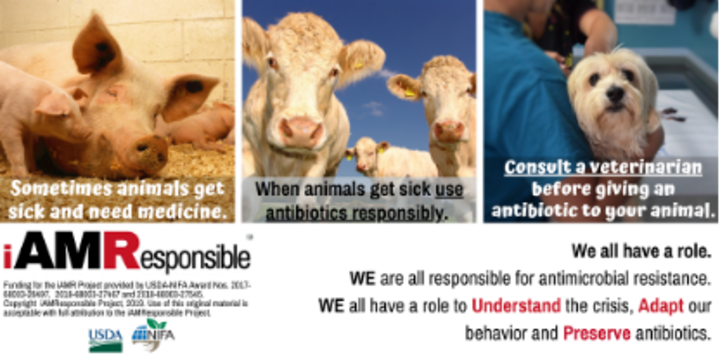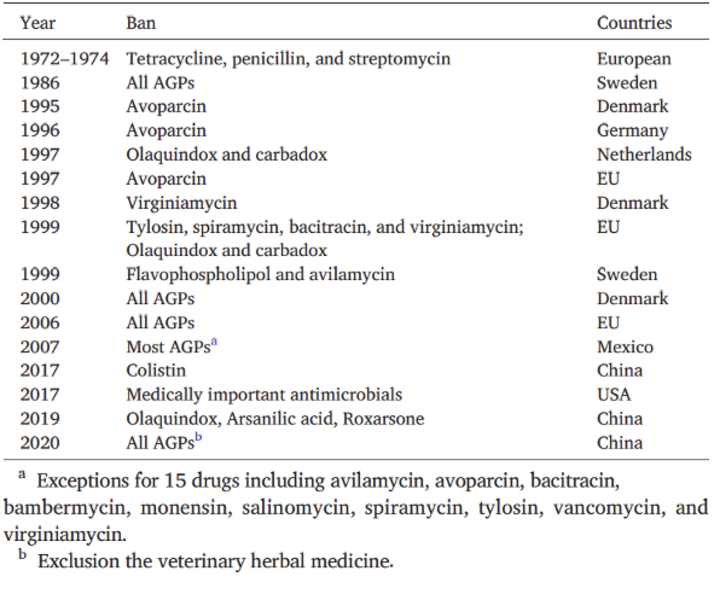Antibiotic use on food animals and its effect on antimicrobial resistance spread and human health.
Most people alive today have never known a world without antibiotics. Antibiotics became widely used to treat bacterial infections in the 1930s and ‘40s, and were quickly labeled a “miracle drug”. But, as widespread use of antibiotics evolved, so did the discovery of antibiotic resistant bacteria. And we have now entered an era where antibiotic resistance is considered one of the biggest worldwide public health challenges of our time. In this article, I will define antibiotic/antimicrobial resistance and summarize the work of researchers covering the following topics:
- Antimicrobials and food animals
- Transition of AMR from animals to humans
- AMR mitigation strategies
What is antibiotic/antimicrobial resistance?
When a microorganism (e.g. bacterium, virus, etc.) adapts in some way to resist the effect of a medicine or product used to kill it, it is said to have developed “antimicrobial resistance,” or AMR. Bacteria are one kind of microorganism – others are viruses, molds, fungi and yeasts. Antibiotic resistance (ABR) refers to the ability of bacteria to resist the effects of one or more antibiotics. An example of antibiotic resistance is methicillin-resistant Staphylococcus aureus, or MRSA, which is a type of bacteria that can cause a skin infection that is difficult to treat.
AMR is not something new, this phenomenon has been occurring in the environment as a natural phenomenon since thousands of years ago, where microorganism have been competing for space and resources. As a result of that, some microorganisms have evolved to produce antibiotics (penicillin was discover from soils’ bacteria!) and other microorganism have created methods to be resistant to those substances. AMR genes that give bacteria protection against antibiotics have been found in 30,000 years old DNA coming from Beringian permafrost sediments!
AMR have not always been linked to humans use of antibiotics, but the modern use of those substances in human medicine and food animals’ production has accelerated the creation of new AMR for drugs that are threating humans’ health. The use of antibiotics on food animals’ production is only one of the causes of AMR nowadays. Human medicine has a big role on this fight, and ANY use of antibiotics can produce AMR. Antibiotics can also be used as anaphylaxises, which occurs when they are used as a preventive measure (i.e. before surgeries, patients are prescribed antibiotics in an attempt to prevent any infection that could result from the surgical procedure). Similar to the use as a treatment against diseases, preventive use of antibiotics represents an AMR risk.
As we can see, AMR is a complex topic. As antibiotics are part of our life, everyone has a role on the mitigation of this human health threat! Now, we are going to focus on the use of antimicrobials on food animals.
Antimicrobials and food animals:

Antimicrobial resistance can reach humans through different ways: from people to people, animals to people, environment to people; and we are still learning and discovering new spread ways. When those AMR microorganisms are pathogenic, they can result in diseases difficult or impossible to treat in humans. AMR are among the top 10 global public health threats, according to the World Health Organization.
Similar to the use of antibiotics in humans, food animal production utilizes antibiotics to treat and prevent diseases and, in some species, to promote growth. Those animals can be a reservoir for AMR, especially when antibiotics are overused or misused. Normally, those bacteria are present in gut animal microbiomes, and are expelled to the environment via excretion. To understand the relation between the use of antimicrobials in food humans and its impacts on the transmission of AMR to humans is key point in the fight against AMRs.
Among the antimicrobials used in food animal production are those deemed “medically important” by the Food and Drug Administration (FDA). Those termed “medically important” are drugs that are used for treating human disease and animal disease. Many drugs used in veterinary medicine are not used in human medicine.
Cattle and swine were, in 2018, the animals that had a largest consumption of medically important drugs, representing 42% and 39% of the 6,653 tons of antimicrobials sold in that year in the US. In the same year, food animals consumed 6,096 tons of non-medically important antimicrobial drugs, with cattle and chicken consuming the largest amounts (61% and 25%, respectively). Tetracyclines (66%), penicillins (12%) and macrolides (8%) were the most prevalent medically important antimicrobial families used in food animals in that year (FDA, 2019).
Transition of AMR from animals to humans:
Similar to the usage of antimicrobials in human health, their use in food animal production creates conditions to the multiplication of AMR microorganisms. When those organisms are resistant to medically important drugs and infect humans, they became a human health problem. In the US, AMR are responsible for 2.8 million infections and 35,000 deaths per year (CDC, 2019).
Links between food animals and common foodborne pathogens like E. coli, Salmonella, enterococci and Staphylococcus aureus show the important role of antibiotic consumption in animals. AMR bacteria can pass AMR characteristics to their descendants, that process is called vertical gene transfer. Also, bacteria can achieve AMR properties though horizontal gene transfer (HGT), a process where microorganisms exchange genetic elements containing AMR genes. HGT is one mechanism by which bacteria adapt to resist the impacts of antibiotics used to treat them.
Several studies have confirmed the transfer of AMR bacteria from animals to humans. This process begins when AMR bacteria spreads inside of food animals after a long-term use of antibiotics. Antibiotics kill the susceptible bacteria and facilitates the growth of AMR bacteria. AMR bacteria can reach the environment after being excreted, and then, via food or a contaminated material, reach the human body. Several AMR bacteria affecting humans have been tracked to an animal or food source worldwide.
AMR Prevention Strategies

Several controls on antimicrobials use in food animal have been imposed in several countries as a measure to decrease the spread of AMR (Table 1). Bans target antimicrobial growth promoters (AGP) and have showed a positive effect on the incidence of AMR on human health. The control of antimicrobial in food production must have a balance between the negative effects on AMR spread and the positive impacts on animal productivity, health and welfare. Also, an increase on the production costs of animal food products will follow a ban on AGP as producers will need to use more expensive practices to control diseases.
Several programs and institutions are working nationally and internationally to combat the AMR spread. Over the past several years, the FDA has initiated change in how medically important antibiotics can be legally used in feed or water for food-producing animals. The changes are intended to eliminate the use of such drugs for production purposes (i.e., growth promotion) and place therapeutic uses in feed and water under a licensed veterinarian’s supervision. In the US, the CDC launched in 1996 the National Antimicrobial Resistance Monitoring System (NARMS), with the objective of protecting public human health by “surveilling AMR in ill people, retail meats and food animals in the US”.
The University of Nebraska-Lincoln is part of the program i(AM)Responsible, which works on the creation and delivering of outreach and educational materials related to AMRs to intended audiences. The topics covered by the program materials include agricultural, environmental and food safety-related AMR research outcomes.
Farmers can reduce the risk of AMR by adopting practices recommended by the CDC in our animal operations:
- Work closely with your veterinarian: A good communication with your veterinarian will help you to decide when antibiotics are needed and what specific actions you can take in your operation to prevent ARM infections.
- Keep animals healthy: Healthy animals are less likely to became sick and require antimicrobials! Follow good husbandry and biosecurity practices, care about your animal welfare standards, vaccinate according to your veterinarian recommendations and implement an appropriate waste management plan.
- Use antibiotics exactly as prescribed: As we have seen in this article, overuse and misuse of antibiotics in human health and animal production could help the dissemination of AMRs. When using antibiotics in your operation, always use the “dose (amount), duration (period of time), and route of administration (how to give antibiotics)” as described by your veterinarian. Keep records of all your antibiotics usage and safely dispose any extra antibiotic.
- Protect yourself and your workers: Make sure that you and your workers/coworkers have an appropriate vaccination, safety trainings, personal protective equipment, toilets and handwashing stations.
During this article we learned that AMR is a complex global human health threat, with multiple actors. Then, we focused on the paper of food animals in this problematic and the ways, as farmers, we can contribute to help in this fight.
Additional resources:
- i(AM)Responsible project’s Twitter and Facebook accounts.
- FDA's Strategy on Antimicrobial Resistance - Questions and Answers.
References:
CDC. (2019). Antibiotic Resistance Threats in the United States, 2019. Atlanta, GA: U.S. Department of Health and Human Services, CDC.
FDA. (2019). 2018 Summary Report on Antimicrobials Sold or Distributed for Use in Food-Producing Animals. U.S. Food and Drug Administration.
Ma, F., Xu, S., Tang, Z., Li, Z., & Zhang, L. (2020). Use of antimicrobials in food animals and impact of transmission of antimicrobial resistance on humans. Biosafety and Health, 1-7. doi:https://doi.org/10.1016/j.bsheal.2020.09.004.
This article was reviewed by Amy Schmidt, Nebraska Extension Specialist and Randy Saner, Nebraska Extension Educator